Principles of Economics (Econ 1008) Online Test 1 Solution, Week 4
VerifiedAdded on 2022/10/19
|6
|1282
|153
Homework Assignment
AI Summary
This document provides a comprehensive solution to an Economics assignment, specifically addressing the concepts of demand, supply, and elasticity within the context of market dynamics and government intervention. The solution analyzes the impact of government actions discouraging sugar consumption and the subsequent shift towards alternatives like coconut sugar, employing supply and demand diagrams to illustrate the resulting changes in equilibrium price and quantity. It further explores the price elasticity of demand for coconut sugar, considering factors such as the availability of substitutes and the product's contribution to consumer budgets. The assignment also examines the effects of taxation on sugar producers, analyzing the incidence of the tax burden and its implications for market efficiency and deadweight loss. The analysis draws upon established economic principles and relevant academic sources to provide a clear and insightful understanding of the subject matter.
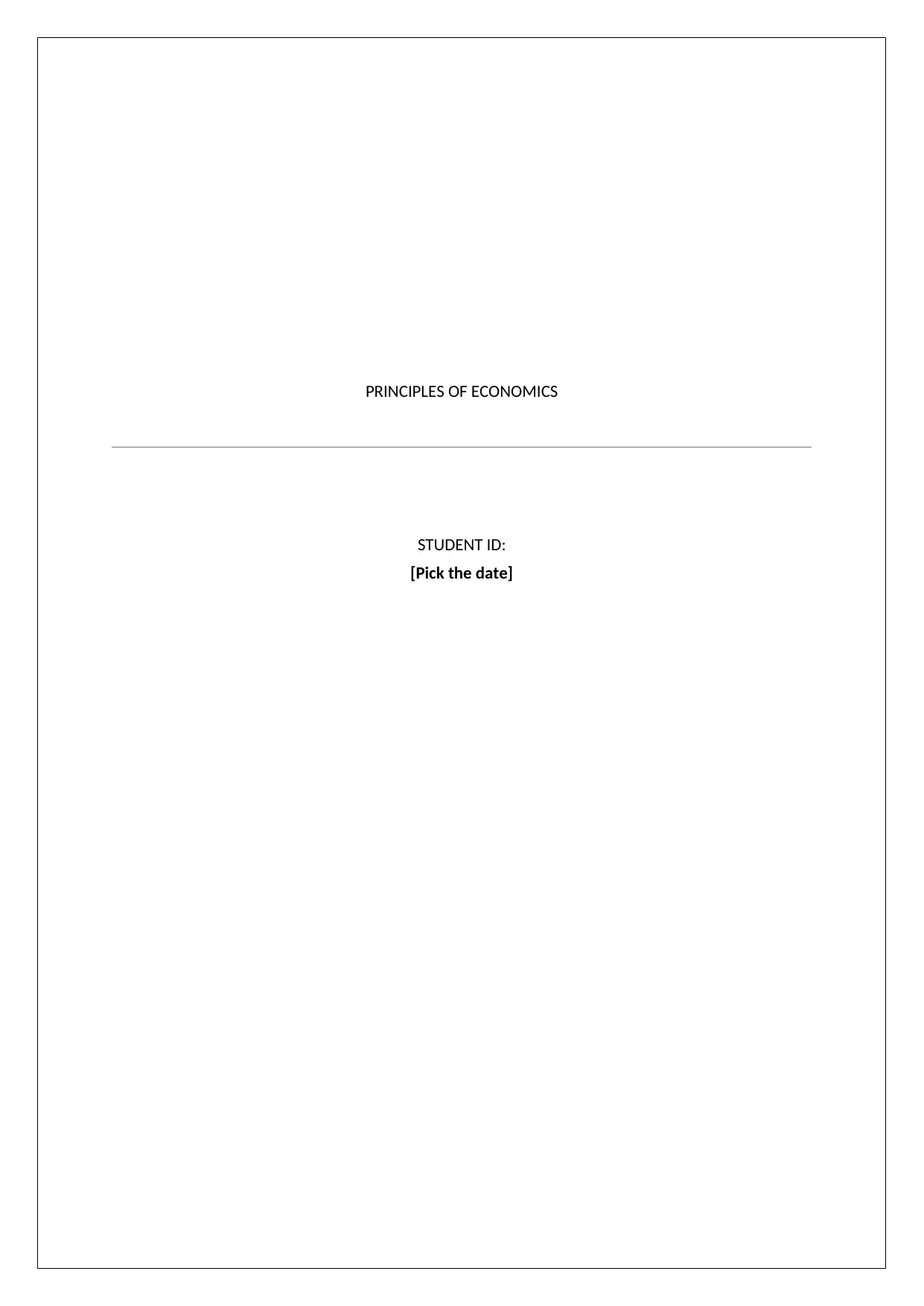
PRINCIPLES OF ECONOMICS
STUDENT ID:
[Pick the date]
STUDENT ID:
[Pick the date]
Paraphrase This Document
Need a fresh take? Get an instant paraphrase of this document with our AI Paraphraser
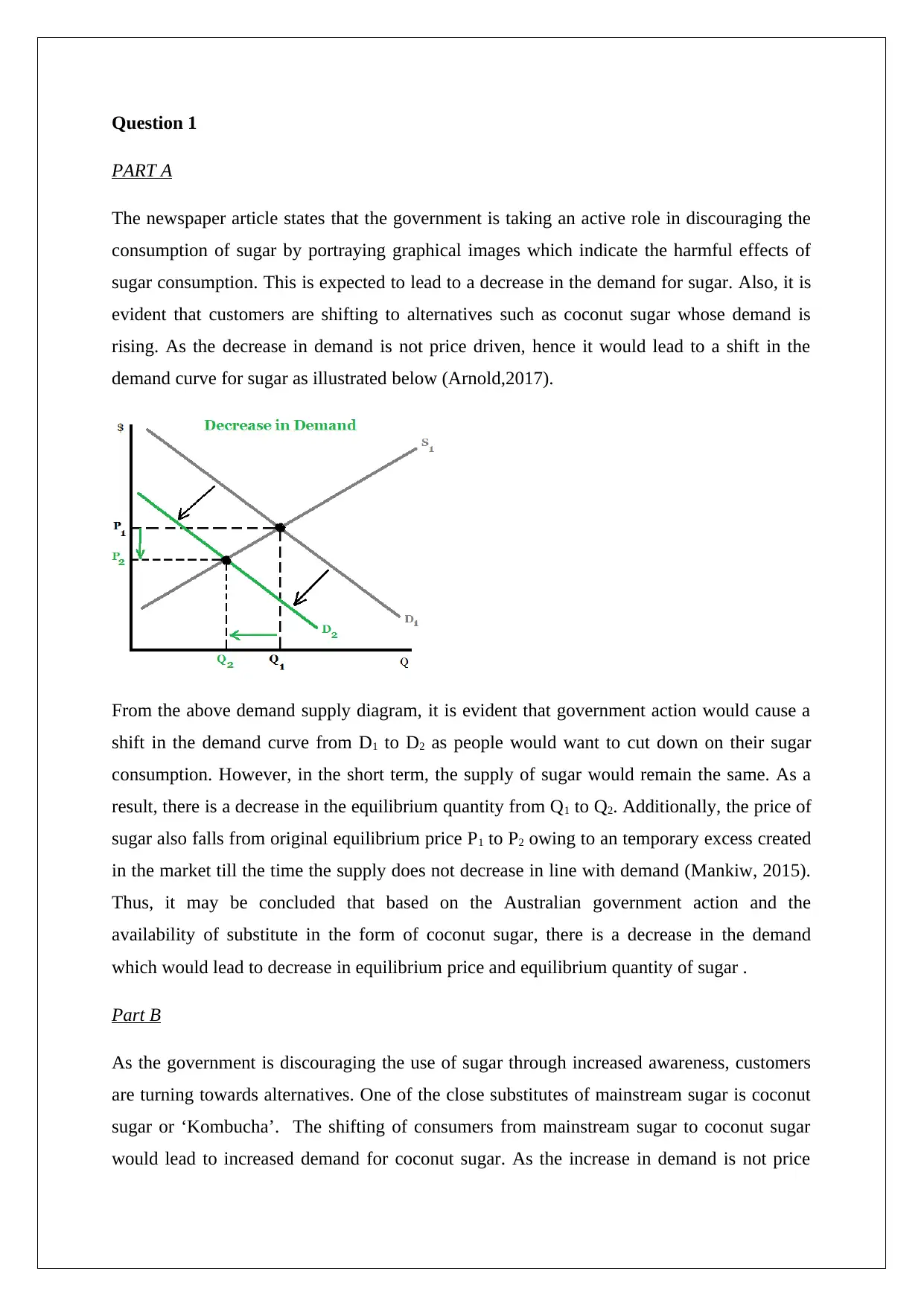
Question 1
PART A
The newspaper article states that the government is taking an active role in discouraging the
consumption of sugar by portraying graphical images which indicate the harmful effects of
sugar consumption. This is expected to lead to a decrease in the demand for sugar. Also, it is
evident that customers are shifting to alternatives such as coconut sugar whose demand is
rising. As the decrease in demand is not price driven, hence it would lead to a shift in the
demand curve for sugar as illustrated below (Arnold,2017).
From the above demand supply diagram, it is evident that government action would cause a
shift in the demand curve from D1 to D2 as people would want to cut down on their sugar
consumption. However, in the short term, the supply of sugar would remain the same. As a
result, there is a decrease in the equilibrium quantity from Q1 to Q2. Additionally, the price of
sugar also falls from original equilibrium price P1 to P2 owing to an temporary excess created
in the market till the time the supply does not decrease in line with demand (Mankiw, 2015).
Thus, it may be concluded that based on the Australian government action and the
availability of substitute in the form of coconut sugar, there is a decrease in the demand
which would lead to decrease in equilibrium price and equilibrium quantity of sugar .
Part B
As the government is discouraging the use of sugar through increased awareness, customers
are turning towards alternatives. One of the close substitutes of mainstream sugar is coconut
sugar or ‘Kombucha’. The shifting of consumers from mainstream sugar to coconut sugar
would lead to increased demand for coconut sugar. As the increase in demand is not price
PART A
The newspaper article states that the government is taking an active role in discouraging the
consumption of sugar by portraying graphical images which indicate the harmful effects of
sugar consumption. This is expected to lead to a decrease in the demand for sugar. Also, it is
evident that customers are shifting to alternatives such as coconut sugar whose demand is
rising. As the decrease in demand is not price driven, hence it would lead to a shift in the
demand curve for sugar as illustrated below (Arnold,2017).
From the above demand supply diagram, it is evident that government action would cause a
shift in the demand curve from D1 to D2 as people would want to cut down on their sugar
consumption. However, in the short term, the supply of sugar would remain the same. As a
result, there is a decrease in the equilibrium quantity from Q1 to Q2. Additionally, the price of
sugar also falls from original equilibrium price P1 to P2 owing to an temporary excess created
in the market till the time the supply does not decrease in line with demand (Mankiw, 2015).
Thus, it may be concluded that based on the Australian government action and the
availability of substitute in the form of coconut sugar, there is a decrease in the demand
which would lead to decrease in equilibrium price and equilibrium quantity of sugar .
Part B
As the government is discouraging the use of sugar through increased awareness, customers
are turning towards alternatives. One of the close substitutes of mainstream sugar is coconut
sugar or ‘Kombucha’. The shifting of consumers from mainstream sugar to coconut sugar
would lead to increased demand for coconut sugar. As the increase in demand is not price
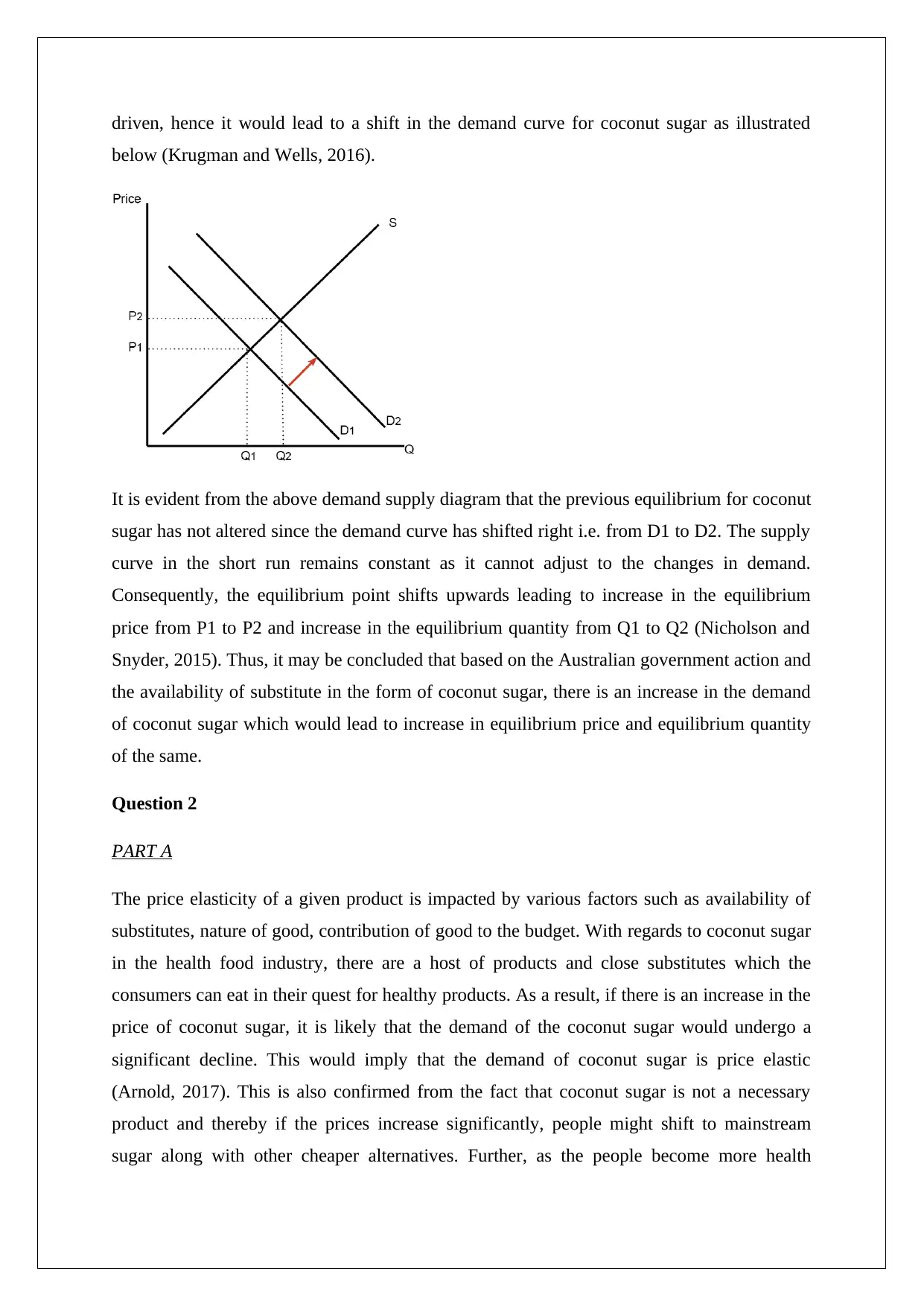
driven, hence it would lead to a shift in the demand curve for coconut sugar as illustrated
below (Krugman and Wells, 2016).
It is evident from the above demand supply diagram that the previous equilibrium for coconut
sugar has not altered since the demand curve has shifted right i.e. from D1 to D2. The supply
curve in the short run remains constant as it cannot adjust to the changes in demand.
Consequently, the equilibrium point shifts upwards leading to increase in the equilibrium
price from P1 to P2 and increase in the equilibrium quantity from Q1 to Q2 (Nicholson and
Snyder, 2015). Thus, it may be concluded that based on the Australian government action and
the availability of substitute in the form of coconut sugar, there is an increase in the demand
of coconut sugar which would lead to increase in equilibrium price and equilibrium quantity
of the same.
Question 2
PART A
The price elasticity of a given product is impacted by various factors such as availability of
substitutes, nature of good, contribution of good to the budget. With regards to coconut sugar
in the health food industry, there are a host of products and close substitutes which the
consumers can eat in their quest for healthy products. As a result, if there is an increase in the
price of coconut sugar, it is likely that the demand of the coconut sugar would undergo a
significant decline. This would imply that the demand of coconut sugar is price elastic
(Arnold, 2017). This is also confirmed from the fact that coconut sugar is not a necessary
product and thereby if the prices increase significantly, people might shift to mainstream
sugar along with other cheaper alternatives. Further, as the people become more health
below (Krugman and Wells, 2016).
It is evident from the above demand supply diagram that the previous equilibrium for coconut
sugar has not altered since the demand curve has shifted right i.e. from D1 to D2. The supply
curve in the short run remains constant as it cannot adjust to the changes in demand.
Consequently, the equilibrium point shifts upwards leading to increase in the equilibrium
price from P1 to P2 and increase in the equilibrium quantity from Q1 to Q2 (Nicholson and
Snyder, 2015). Thus, it may be concluded that based on the Australian government action and
the availability of substitute in the form of coconut sugar, there is an increase in the demand
of coconut sugar which would lead to increase in equilibrium price and equilibrium quantity
of the same.
Question 2
PART A
The price elasticity of a given product is impacted by various factors such as availability of
substitutes, nature of good, contribution of good to the budget. With regards to coconut sugar
in the health food industry, there are a host of products and close substitutes which the
consumers can eat in their quest for healthy products. As a result, if there is an increase in the
price of coconut sugar, it is likely that the demand of the coconut sugar would undergo a
significant decline. This would imply that the demand of coconut sugar is price elastic
(Arnold, 2017). This is also confirmed from the fact that coconut sugar is not a necessary
product and thereby if the prices increase significantly, people might shift to mainstream
sugar along with other cheaper alternatives. Further, as the people become more health
⊘ This is a preview!⊘
Do you want full access?
Subscribe today to unlock all pages.

Trusted by 1+ million students worldwide
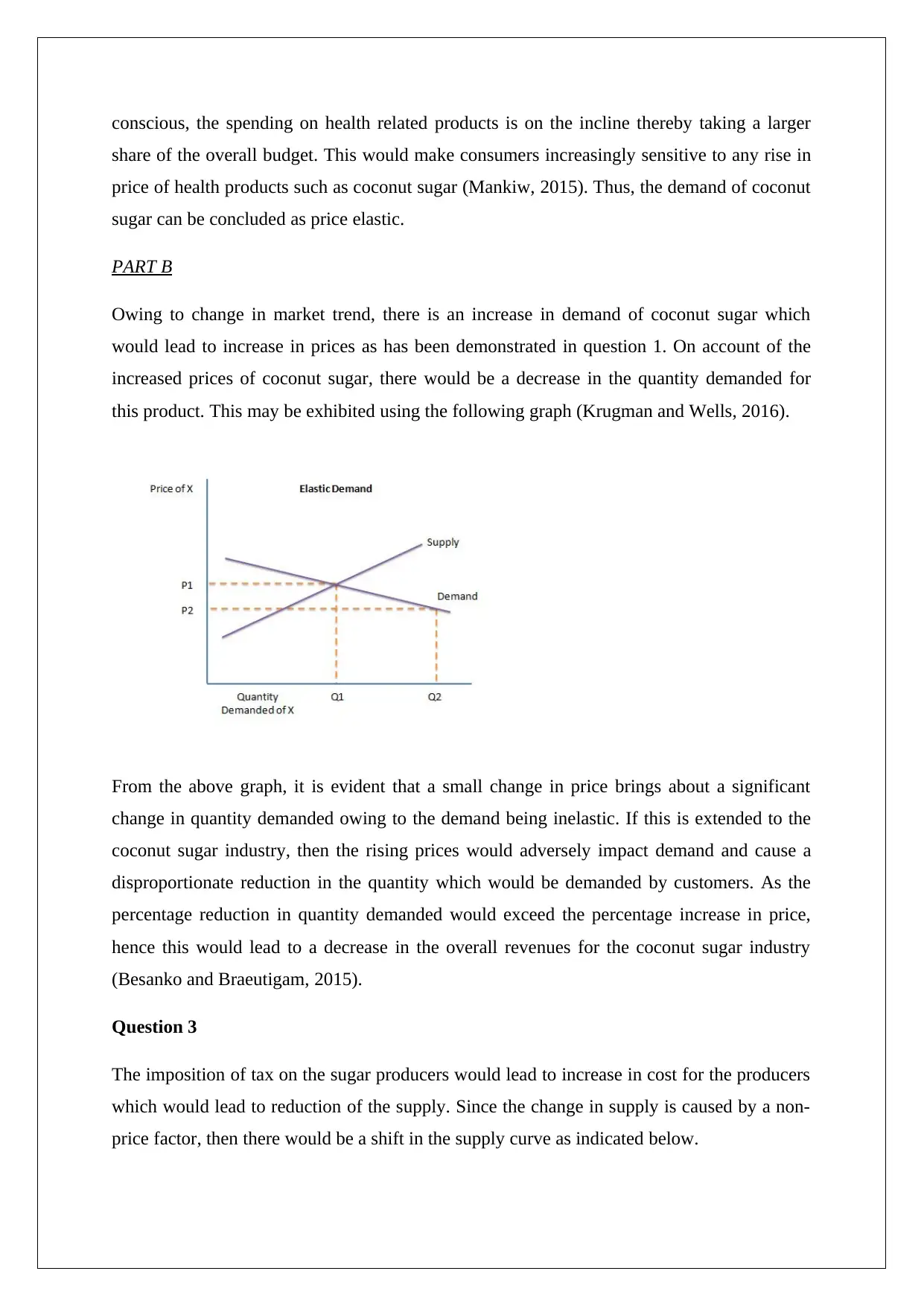
conscious, the spending on health related products is on the incline thereby taking a larger
share of the overall budget. This would make consumers increasingly sensitive to any rise in
price of health products such as coconut sugar (Mankiw, 2015). Thus, the demand of coconut
sugar can be concluded as price elastic.
PART B
Owing to change in market trend, there is an increase in demand of coconut sugar which
would lead to increase in prices as has been demonstrated in question 1. On account of the
increased prices of coconut sugar, there would be a decrease in the quantity demanded for
this product. This may be exhibited using the following graph (Krugman and Wells, 2016).
From the above graph, it is evident that a small change in price brings about a significant
change in quantity demanded owing to the demand being inelastic. If this is extended to the
coconut sugar industry, then the rising prices would adversely impact demand and cause a
disproportionate reduction in the quantity which would be demanded by customers. As the
percentage reduction in quantity demanded would exceed the percentage increase in price,
hence this would lead to a decrease in the overall revenues for the coconut sugar industry
(Besanko and Braeutigam, 2015).
Question 3
The imposition of tax on the sugar producers would lead to increase in cost for the producers
which would lead to reduction of the supply. Since the change in supply is caused by a non-
price factor, then there would be a shift in the supply curve as indicated below.
share of the overall budget. This would make consumers increasingly sensitive to any rise in
price of health products such as coconut sugar (Mankiw, 2015). Thus, the demand of coconut
sugar can be concluded as price elastic.
PART B
Owing to change in market trend, there is an increase in demand of coconut sugar which
would lead to increase in prices as has been demonstrated in question 1. On account of the
increased prices of coconut sugar, there would be a decrease in the quantity demanded for
this product. This may be exhibited using the following graph (Krugman and Wells, 2016).
From the above graph, it is evident that a small change in price brings about a significant
change in quantity demanded owing to the demand being inelastic. If this is extended to the
coconut sugar industry, then the rising prices would adversely impact demand and cause a
disproportionate reduction in the quantity which would be demanded by customers. As the
percentage reduction in quantity demanded would exceed the percentage increase in price,
hence this would lead to a decrease in the overall revenues for the coconut sugar industry
(Besanko and Braeutigam, 2015).
Question 3
The imposition of tax on the sugar producers would lead to increase in cost for the producers
which would lead to reduction of the supply. Since the change in supply is caused by a non-
price factor, then there would be a shift in the supply curve as indicated below.
Paraphrase This Document
Need a fresh take? Get an instant paraphrase of this document with our AI Paraphraser
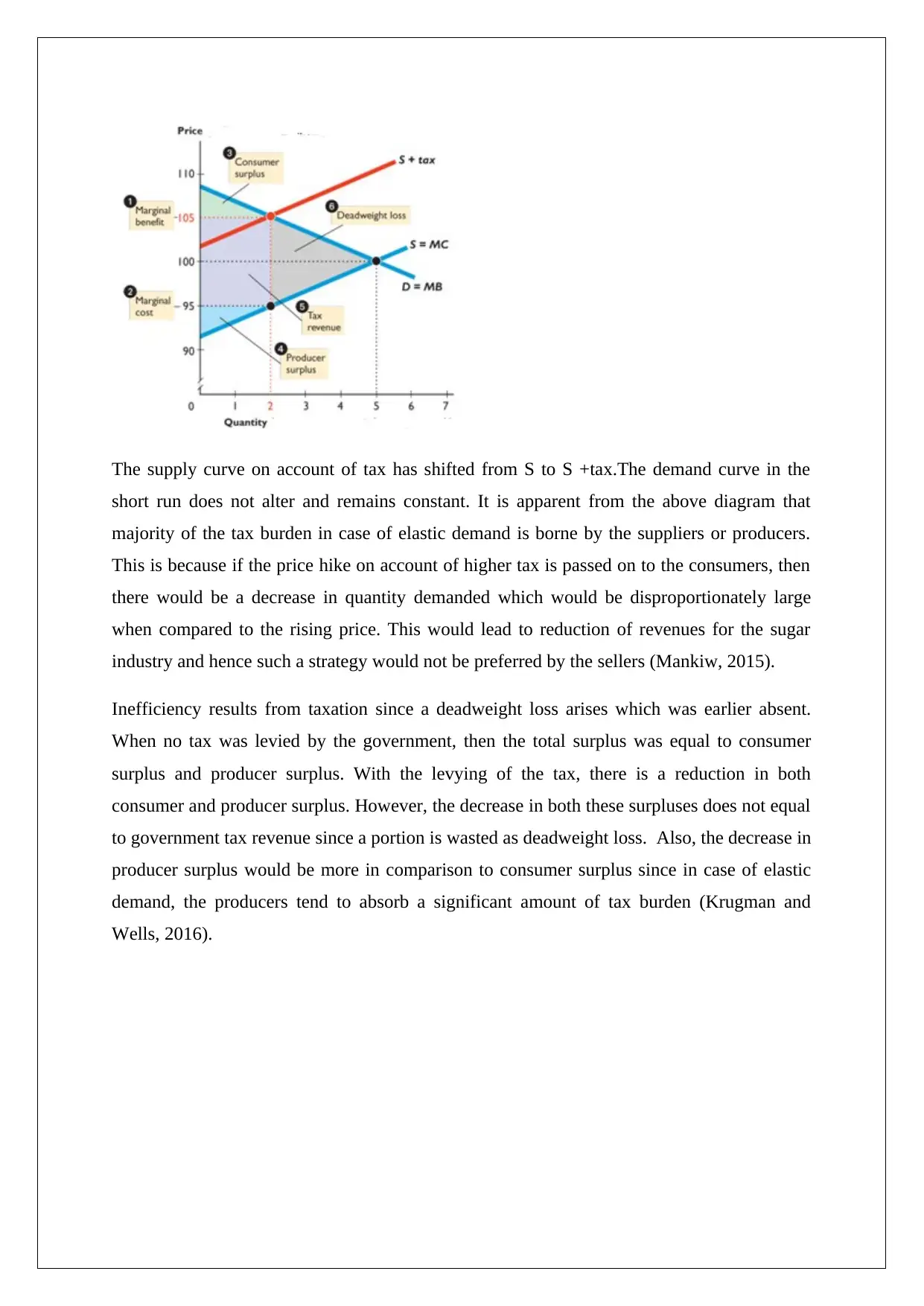
The supply curve on account of tax has shifted from S to S +tax.The demand curve in the
short run does not alter and remains constant. It is apparent from the above diagram that
majority of the tax burden in case of elastic demand is borne by the suppliers or producers.
This is because if the price hike on account of higher tax is passed on to the consumers, then
there would be a decrease in quantity demanded which would be disproportionately large
when compared to the rising price. This would lead to reduction of revenues for the sugar
industry and hence such a strategy would not be preferred by the sellers (Mankiw, 2015).
Inefficiency results from taxation since a deadweight loss arises which was earlier absent.
When no tax was levied by the government, then the total surplus was equal to consumer
surplus and producer surplus. With the levying of the tax, there is a reduction in both
consumer and producer surplus. However, the decrease in both these surpluses does not equal
to government tax revenue since a portion is wasted as deadweight loss. Also, the decrease in
producer surplus would be more in comparison to consumer surplus since in case of elastic
demand, the producers tend to absorb a significant amount of tax burden (Krugman and
Wells, 2016).
short run does not alter and remains constant. It is apparent from the above diagram that
majority of the tax burden in case of elastic demand is borne by the suppliers or producers.
This is because if the price hike on account of higher tax is passed on to the consumers, then
there would be a decrease in quantity demanded which would be disproportionately large
when compared to the rising price. This would lead to reduction of revenues for the sugar
industry and hence such a strategy would not be preferred by the sellers (Mankiw, 2015).
Inefficiency results from taxation since a deadweight loss arises which was earlier absent.
When no tax was levied by the government, then the total surplus was equal to consumer
surplus and producer surplus. With the levying of the tax, there is a reduction in both
consumer and producer surplus. However, the decrease in both these surpluses does not equal
to government tax revenue since a portion is wasted as deadweight loss. Also, the decrease in
producer surplus would be more in comparison to consumer surplus since in case of elastic
demand, the producers tend to absorb a significant amount of tax burden (Krugman and
Wells, 2016).
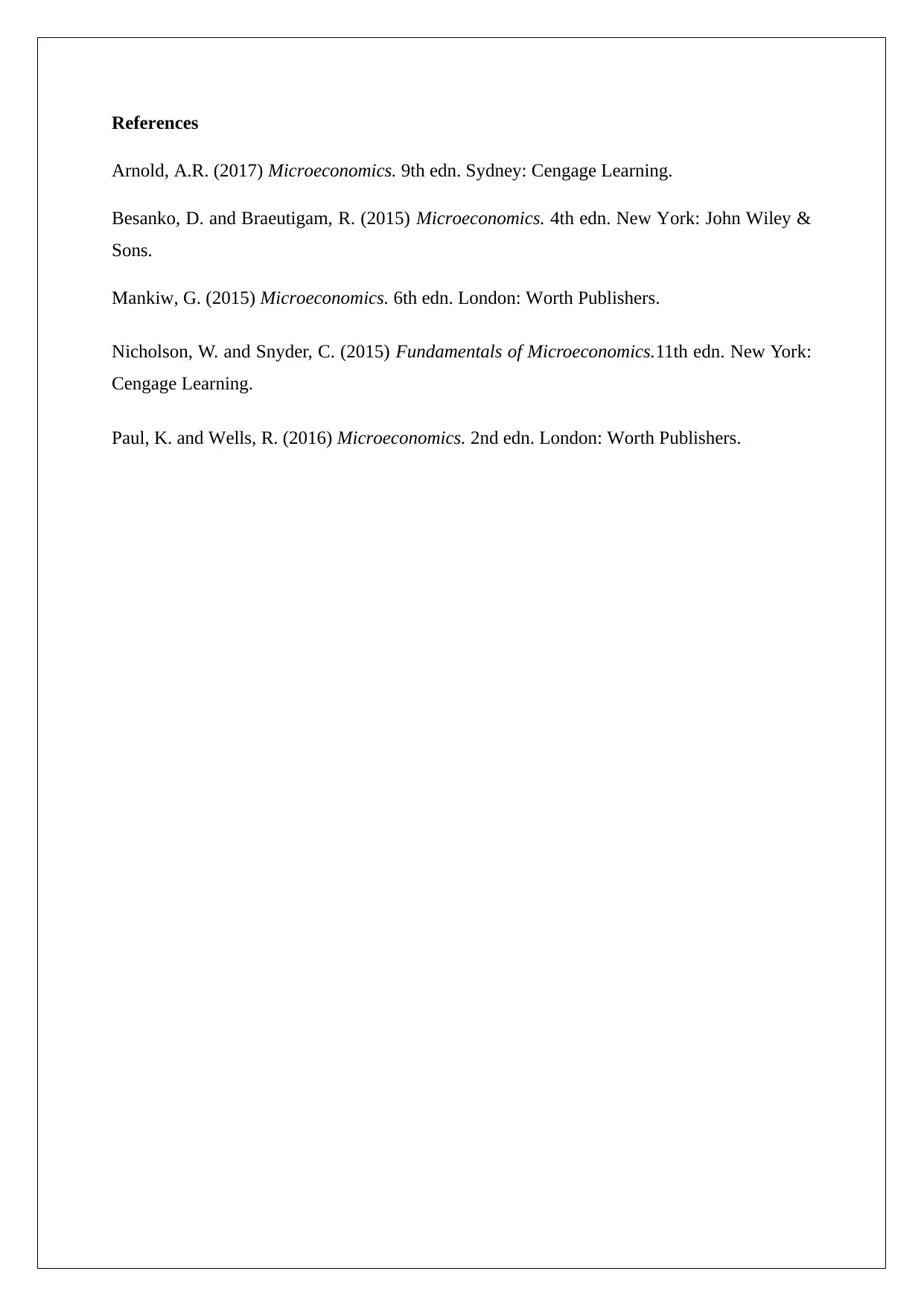
References
Arnold, A.R. (2017) Microeconomics. 9th edn. Sydney: Cengage Learning.
Besanko, D. and Braeutigam, R. (2015) Microeconomics. 4th edn. New York: John Wiley &
Sons.
Mankiw, G. (2015) Microeconomics. 6th edn. London: Worth Publishers.
Nicholson, W. and Snyder, C. (2015) Fundamentals of Microeconomics.11th edn. New York:
Cengage Learning.
Paul, K. and Wells, R. (2016) Microeconomics. 2nd edn. London: Worth Publishers.
Arnold, A.R. (2017) Microeconomics. 9th edn. Sydney: Cengage Learning.
Besanko, D. and Braeutigam, R. (2015) Microeconomics. 4th edn. New York: John Wiley &
Sons.
Mankiw, G. (2015) Microeconomics. 6th edn. London: Worth Publishers.
Nicholson, W. and Snyder, C. (2015) Fundamentals of Microeconomics.11th edn. New York:
Cengage Learning.
Paul, K. and Wells, R. (2016) Microeconomics. 2nd edn. London: Worth Publishers.
⊘ This is a preview!⊘
Do you want full access?
Subscribe today to unlock all pages.

Trusted by 1+ million students worldwide
1 out of 6
Related Documents
Your All-in-One AI-Powered Toolkit for Academic Success.
+13062052269
info@desklib.com
Available 24*7 on WhatsApp / Email
![[object Object]](/_next/static/media/star-bottom.7253800d.svg)
Unlock your academic potential
Copyright © 2020–2025 A2Z Services. All Rights Reserved. Developed and managed by ZUCOL.




